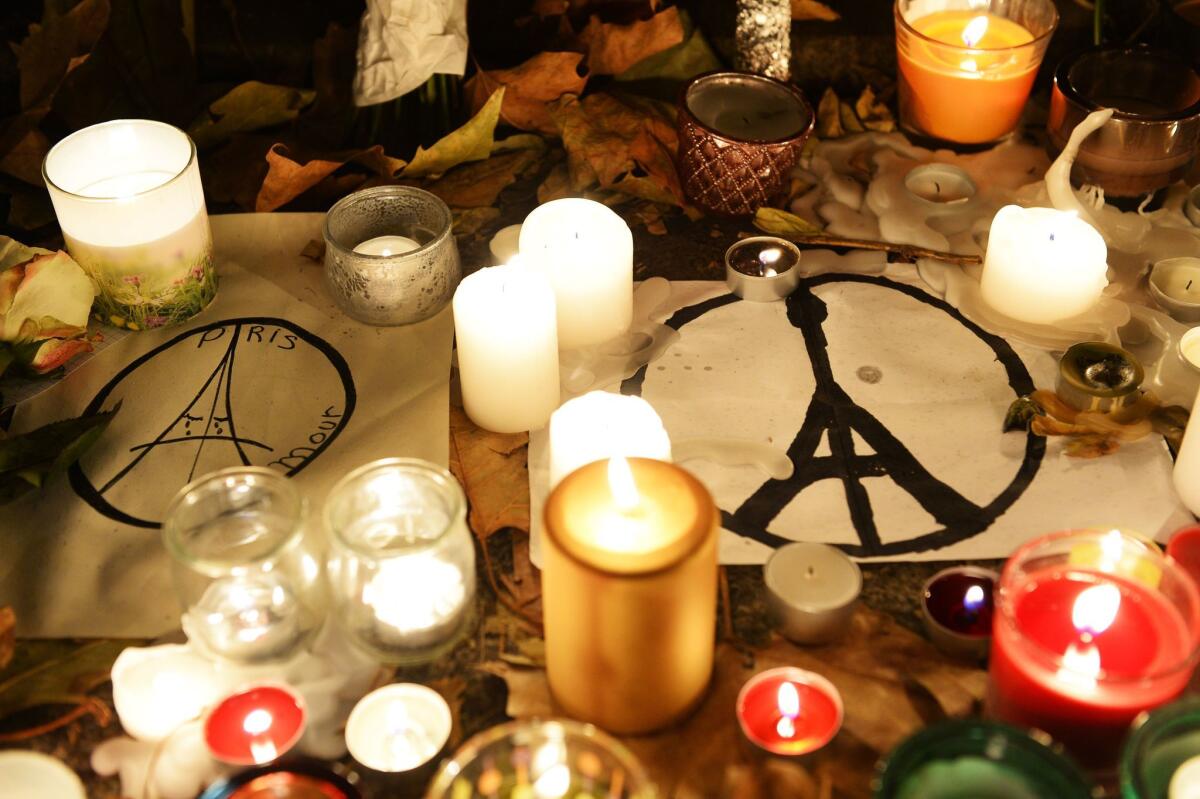How L.A.’s teachers are talking about Paris

Candles and messages are left at a makeshift memorial next to the Bataclan concert hall in Paris.
- Share via
By the time teachers understood the magnitude of Friday’s terror attacks on Paris, school was over, or close to it. So students throughout Southern California came to school Monday morning with a few questions:
Who were the people being killed in Paris? Who was doing the killing? Why did they hear about France so much, but not about the tragedies that happen in other countries, like Lebanon?
Teachers are often the first people to shape how children and teens understand a world event. They’re the people to whom students come with questions — that was the case during 9/11 and after the Boston Marathon bombing. So at least some teachers were expecting those questions on Monday.
Every week, Santee Education Complex teacher Randall Bustamante starts his ethnic studies class with a free writing session. The students journal whatever is on their minds, whatever baggage they’re carrying from the weekend. On Monday, some wrote about the attacks on Paris.
Bustamante had thought his high school students would want to discuss what happened, and he wanted to talk to them about problem-solving. But many students learned the little they knew about the attack from snippets on Instagram and Facebook. And many were misguided.
“There was a lot to get into and I had to decide, ‘Am I really going to ... get into the nitty gritty or not?’” He had only 10 to 15 minutes to spend on the topic before moving on to the lesson plan.
The class is currently learning about media analysis, so Bustamante allowed his students to focus on media coverage instead of the history that led to these attacks.
“The conversation today was … what are we paying attention to and what is being ignored and how does social media play a part in that?” Bustamante said. He had prepared images and videos to show the class and discuss in case they wanted to talk about France: Facebook profile pictures colored by the French flag overlay, and a cartoon that showed the media covering France, but not other countries that experienced violence recently.
In San Diego, world history teacher Tommy Flanagan addressed the issue with a younger group: seventh-grade students. He teaches at Mary McLeod Bethune Middle School, where his students just finished a unit on the rise and spread of Islam.
Although the class has moved on to the study of West Africa, Flanagan put the new material on hold Monday morning. Flanagan instead asked the students what big world event had happened since they last saw each other (he was out on Friday). They talked about Paris, and Flanagan asked if they knew of any other recent attacks that had occurred. Most did not.
So he broke the students into three groups, each assigned to find reputable news sources and learn about recent terror attacks in one of three places: Paris, Beirut and Kenya, where an April attack at a college left 147 dead.
On Tuesday, the groups will present what they’ve learned, Flanagan said.
Eleventh-grade U.S. history students at Downtown Magnets High School spent an hour on the topic on Monday, said Daniel Jocz, a history teacher at the school and one of California’s teachers of the year.
Like Bustamante, Jocz thought the students would come in with at least a basic understanding of the situation. But their information had also mostly come from social media, and students’ world history education pretty much ends at World War II, he said.
“Today I ... carved out [the] opportunity for them to just ask questions and for them to get a grip on what ISIS is,” Jocz said.
He also showed them images and video of the attacks so they would know what had actually happened. Seeing those images — a Cambodian restaurant in Paris that they could have been in as study-abroad students, a concert they could have been enjoying before it erupted into chaos — caused the students to relate.
Students (and adults) swipe past tragedies on Facebook and Twitter every day, and that might have a desensitizing effect, he said. “When I’m teaching ... I want them to be empathetic.”
The students are currently studying U.S. foreign policy, so Jocz played a clip of President Obama’s press conference, then asked them what advice they would give Obama regarding America’s response to the attacks. They discussed drone strikes, bombings and diplomacy, but didn’t come up with any good solutions.
That confusion is part of Jocz’ goal, he said — to teach students less than a year from voting age that despite what politicians will be feeding them, there is rarely ever one neat solution to any problem.
“Part of my job is to just totally confuse the hell out of them,” Jocz said. “If they can get clarity of the confusion, that’ll make them better civic participants.”
Reach Sonali Kohli on Twitter @Sonali_Kohli or by email at [email protected].
ALSO
USC pledges new steps to increase diversity, multicultural understanding
Hundreds gather at Cal State Long Beach to remember ‘a beautiful soul’
After days of protests, students occupy building at Occidental College
More to Read
Sign up for Essential California
The most important California stories and recommendations in your inbox every morning.
You may occasionally receive promotional content from the Los Angeles Times.











